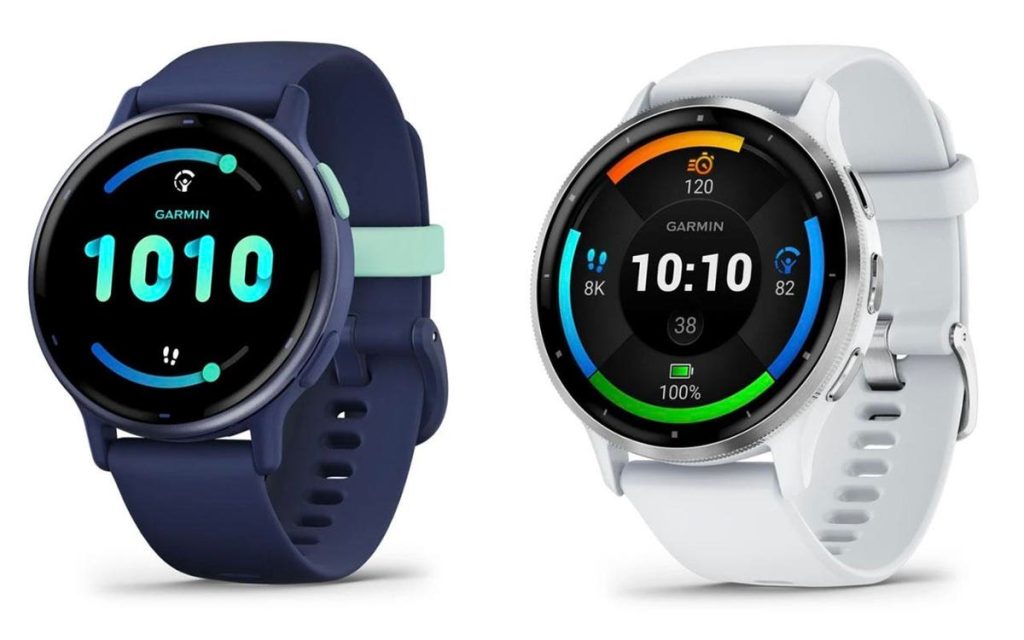Garmin never stops flinging out new watches. But the most recent, the Vivoactive 5, is a little different.
This is part of a series that has not been updated for quite some time. The Vivoactive 4 was released way back in 2019.
Garmin’s update represents a huge change for this line, one that brings it surprisingly close in features and style to the more expensive Garmin Venu 3. You’re left wondering: is the Venu really worth the additional $150?
They both have full GPS, punchy OLED displays and a lot of fitness features. But here’s what separates the two.
Vivoactive 5 is a little smaller… or larger
There are two sizes of Garmin Venu 3. The standard has a 45mm-wide face, while the 41mm model is known as the Venu 3S. This is the naming system Garmin uses across its models.
Its Vivoactive 5 line only comes in one size, though, and it slots between the two at 42.2mm across.
Curiously, the Vivoactive 5 is slightly lighter than either of the Venu 3 sizes, though, at just 36g with strap. Why? Well…
Steel versus aluminium
The Garmin Vivoactive has an aluminium bezel, the Venu 3 a stainless steel one. Steel is a lot harder, more scratch-resistant, but is also heavier. This may account for the higher weight in the Venu 3 series.
Garmin’s Venu 3 is a little tougher, but these watches both have 5ATM water resistance. As such, we’re mostly talking about a watch’s ability to stay looking cosmetically sharp after rough treatment. They also use the same Gorilla Glass 3 screen protection.
Speaker and microphone
The Venu series is where Garmin explores the more smartwatch-style end of wearables. As such, the Venu 3 has a speaker and microphone, which enables hands-free calls and communication with your phone’s digital assistant.
This is fairly limited, though, as the Garmin Venu 3 effectively just captures the audio that would otherwise be played through your phone speaker. It still needs to be connected to your phone over Bluetooth, and doesn’t show results on the watch screen itself. This is all about audio.
The speaker can also play music, where the Vivoactive 5 only streams to Bluetooth headphones/speakers. And it can fire out workout updates as you go, typically per km when running.
Altimeter for stair counting
The Garmin Vivoactive 5 lacks a barometric altimeter, found in the Venu 3 series. This is what lets a wearable passively record how many flights of stairs you ascend, or the equivalent of that on other terrain.
This is a pretty neat passive fitness tracking element, one that enriches a watch if you aren’t going to do lots of active GPS-tracked sessions.
A next-generation HR array
If you are more about active tracking, running and so on, there’s another advantage to the Garmin Venu 3. It uses Garmin’s latest-generation heart rate sensor array, while the Vivoactive 5 has the last version.
You can see the changes just from a glance. Where the Vivoactive 5 has two LED blocks and four light sensors, the Venu 3 has six LED blocks and four light sensors.
The additional four outer green LEDs are used when you track an exercise. It gives the light sensors more to work with, the aim being to compensate for the difficulties introduced when motion comes into the picture.
It may make the Venu 3 more accurate in edge cases, but the Elevate V4 heart rate array of the Vivoactive 5 is already celebrated. And has been used in some very expensive watches in the fairly recent past, including the Garmin Fenix 7.
Advanced cycling features
The Venu 3 has a couple of advanced cycling feature the Vivoactive 5 lacks. Garmin’s cheaper watch can’t be used to control smart turbo trainers, a neat feature if you’re big on indoor cycling.
It also can’t connect to power meters, just cadence and speed sensors. If your main sport is cycling, you may want to think twice about the Vivoactive 5.
Half the storage
You get 4GB storage with the Garmin Vivoactive 5, 8GB with the Venu 3. Neither of these watches supports downloadable maps, the main reason to get lots of storage in a Garmin watch. However, that extra memory will let you store more music tracks, more audiobooks or podcasts.
Both watches support music streaming, one of the most important features if you want to be able to head our for a run without your phone.
Battery life
There are no major wins for the Venu 3 on battery life. It’s all about size here. The 42mm Vivoactive 5 lasts up to 11 days, the smaller 41mm Venu 3S up to 10 days and the 45mm Venu 3 up to 14 days.
Battery life basically scales up with the size of the watch, but all will last a decent amount of time as long as you don’t use the “always on” mode. This roughly halves battery life.
Vivoactive 5 vs Venu 3: Early verdict
Garmin has pitched this one fairly well. The Vivoactive 5 will be just as good a fitness watch for many people as the Venu 3.
However, there are some significant differences here, ones that could justify the $150 extra spend. You probably won’t care about all of the changes, but if a couple will impact you significantly, that upgrade is going to look tempting.
You should also keep an eye on the Venu 2 and Venu 2 Plus for possible sales. They have the altimeter the Vivoactive 5 lacks, as well as a stainless steel bezel.
Read the full article here










